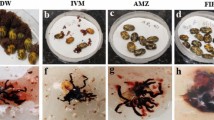Summary
Morphometric analysis of the epithelial lining of the stomach of A. aegypti suggests that digestion of the first blood meal in the stomach of this species can be viewed as a series of phases that can be correlated with physiological data from the literature.
In phase Ia (0–10 h after blood meal [abm]) the whorls of the rough endoplasmic reticulum unfold, the Golgi zones increase, and the basal labyrinth is enlarged. This coincides with processes of synthesis and secretion (e.g., peritrophic membrane, esterases and lipases) and transport by the stomach epithelium. In phase Ib (10–20 habm) the cellular parameters measured further increase, indicating high synthetic and secretory activities (e.g., digestive enzymes). In phase Ic (20–30 habm) cell structures involved in synthesis and secretion still exhibit high values coinciding with maximal activity of proteases in the gut. Enhanced surface area of microvilli, prominent lipid inclusions, and appearance of glycogen deposits in the gut epithelium suggest increased absorption, storage, and transport functions of the stomach cells. In phase II (30–36 habm) structural alteration points to a gradual shift from synthesis and secretion to absorption, partial storage, and transport of nutrients. In phase III (36–72 habm) the cellular apparatus is reduced concomitant with the ending of the digestive cycle. Lipid inclusions and glycogen deposits disappear from the stomach epithelum.
Zusammenfassung
Morphometrische Untersuchungen des Magenepithels von A. aegypti weisen darauf hin, daß die Verdauung des ersten Blutmahls in eine Reihe von Phasen gegliedert werden kann, die sich mit physiologischen Daten aus der Literatur korrelieren lassen. In einer Phase Ia (0–10 h nach Blutmahl [BM]) entfalten sich die “whorls” des rauhen endoplasmatischen Retikulums, die Golgi-Zonen werden größer, und das basale Labyrinth wird erweitert. Dies stimmt mit Synthese- und Sekretionsprozessen (z.B. peritrophische Membran, Esterasen, Lipasen) und mit Transportvorgängen durch das Magenepithel überein. In Phase Ib (10–20 h nach BM) nehmen die gemessenen zellulären Parameter weiter zu und weisen damit auf hohe Synthese- und Sekretionsaktivitäten (z.B. Verdauungsenzyme) hin. In Phase Ic (20–30 h nach BM) zeigen die an Synthese und Sekretion beteiligten Zellstrukturen, in Übereinstimmung mit der maximalen Proteasenaktivität im Darm, immer noch hohe Werte. Vergrößerte Mikrovillioberfläche, auffallende Lipideinschlüsse und Auftreten von Glykogendepots im Magenepithel deuten auf erhöhte Resorptions-, Speicher- und Transportfunktionen der Zellen hin. In Phase II (30–36 h nach BM) läßt sich anhand der strukturellen Veränderungen der Wechsel von Synthese- und Sekretionvorgängen zu Resorption, teilweiser Speicherung und Transport von Verdauungsprodukten erkennen. In Phase III (36–72 h nach BM) wird der Zellapparat in Übereinstimmung mit dem Ende der Verdauung reduziert. Lipid- und Glykogendepots werden mobilisiert und verschwinden fast vollständig aus den Magenepithelzellen.
Similar content being viewed by others
References
Akov, S.: Protein digestion in haematophagous insects. In “Insect and mite nutrition”. Amsterdam: North Holland 231–240 (1972)
Briegel, H., Lea, A.O.: Relationship between protein and proteolytic activity in the midgut of mosquitoes. J. Insect Physiol. 21, 1597–1604 (1975)
Fuchs, M.S., Fong, W.F.: Inhibition of blood digestion by α-amanitin and actinomycin D and its effect on ovarian development in Aedes aegypti. J. Insect Physiol. 22, 465–472 (1976)
Gander, E.: Zur Histologie und Histochemie des Mitteldarmes von Aedes aegypti und Anopheles stephensi im Zusammenhang mit der Blutverdauung. Acta Trop. 25, 133–175 (1968)
Gass, R.F.: Einfluß der Blutverdauung auf die Entwicklung von Plasmodium gallinaceum (Brumpt) im Mitteldarm von Aedes aegypti L. Ph. D. Dissertation. Univ. Basel (1977)
Geering, K., Freyvogel, T.A.: Lipase activity and Stimulation mechanism of esterases in the midgut of female Aedes aegypti. J. Insect Physiol. 21, 1251–1256 (1975)
Gooding, R.H.: The digestive processes of haematophagous insects. IV. Secretion of trypsin by Aedes aegypti (Diptera: Culicidae). Canad. Entomol. 105, 599–603 (1973)
Hecker, H.: Structure and function of midgut epithelial cells in culicidae mosquitoes (Insecta, Diptera). Cell Tissue Res. 184, 321–341 (1977)
Hecker, H., Brun, R., Reinhardt, C., Burri, P.H.: Morphometric analysis of the midgut of female Aedes aegypti L. (Insecta, Diptera) under various physiological conditions. Cell Tissue Res. 152, 31–49 (1974)
Hecker, H., Rudin, W.: Normal versus α-amanitin induced cellular and ribosomal dynamics of midgut epithelial cells in female Aedes aegypti L. (Insecta, Diptera) in response to blood feeding. Europ. J. Cell Biol. (in press)
Lehane, M.J.: Transcellular absorption of lipids in the midgut of the stablefly, Stomoxys calcitrans. J. Insect Physiol. 23, 945–954 (1977)
McCabe, C.T., Bursell, E.: Metabolism of digestive products in the tsetse fly, Glossina morsitaons. Insect Biochem. 5, 769–779 (1975)
Rudin, W., Hecker, H.: Morphometric comparison of the midgut epithelial cells in male and female Aedes aegypti L. (Insecta, Diptera). Tissue and Cell 8, 459–470 (1976)
Samish, M., Akov, S.: Influence of feeding on midgut protease activity in Aedes aegypti. Israel J. Entomol. 7, 41–48 (1972)
Weibel, E.R.: Stereological principles for morphometry in electron microscopic cytology. Int. Rev. Cytol. 26, 235–302 (1969)
Yeates, R.A.: Proteinases of female Aedes aegypti (L.) Acta Trop. 35, 195–196 (1978)
Author information
Authors and Affiliations
Additional information
We thank Dr. R.A. Yeates for critical discussion of the manuscript. The skillful technical assistance of Miss C. Fauser and the typing of the manuscript by Miss U. Steffen are gratefully acknowledged
Rights and permissions
About this article
Cite this article
Rudin, W., Hecker, H. Functional morphology of the midgut of Aedes aegypti L. (Insecta, Diptera) during blood digestion. Cell Tissue Res. 200, 193–203 (1979). https://doi.org/10.1007/BF00236412
Accepted:
Issue Date:
DOI: https://doi.org/10.1007/BF00236412




